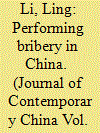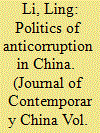|
|
|
Sort Order |
|
|
|
Items / Page
|
|
|
|
|
|
|
| Srl | Item |
| 1 |
ID:
154336


|
|
|
|
|
| Summary/Abstract |
Possession of a brand is a sine qua non for economic success, not least because it connotes trust in delivering the value promised. Although Western arms exporters offer branded systems whose sales are influenced by price, there is a plethora of other economic variables, such as offset requirements and life-cycle support. Entrants to the international arms market will struggle without such arms “packages.” China’s entry, however, goes beyond the traditional economic paradigm. A four-stage historical model offers the backdrop for identifying the drivers that have forged its market entry into 55 countries worldwide. The strategy initially focused on sales of rudimentary military equipment for political purposes, but recently it has begun to commercialize exports, repositioning them from a low- to a high-tech sales trajectory. A Sino “brand” is thus emerging, reflecting both competitiveness and diplomatic considerations, especially non-interference in client state domestic affairs.
|
|
|
|
|
|
|
|
|
|
|
|
|
|
|
|
| 2 |
ID:
158660


|
|
|
|
|
| Summary/Abstract |
The tension between mobilizing resources to meet education-related growth targets and regularizing educational funding for a more stable and sustainable growth is structurally rooted in China’s educational system, which features growth-oriented, centralized mandates and county-based, decentralized financing. It was manifested in 2012, when China experienced a ‘great leap’ in educational expenditure. Based on interviews and school-level data from a province in western China, this article suggests that the ‘great leap’ was real rather than fabricated. Local governments have demonstrated remarkable capacity in resource mobilization involving both formal and informal strategies. It also shows the scarring effects of too much mobilization. The ‘great leap’ has clearly stressed and strained local governments to the extent that there is clear evidence of policy non-compliance and greater irregularity in government funding for education in the aftermath.
|
|
|
|
|
|
|
|
|
|
|
|
|
|
|
|
| 3 |
ID:
102783


|
|
|
|
|
| Publication |
2011.
|
| Summary/Abstract |
Unlike most current academic studies on corruption in China, which focus on the theme of how political, economic and social environments have caused corruption at the macro-level, this paper takes a micro-view. It concentrates on the question of how corruption, notably bribery, takes place between a briber and the bribed. Moreover, it examines what exact role guanxi-practice plays in corrupt exchange and, more importantly, why it constitutes a critical element. Through in-depth case-studies derived from extensive fieldwork, this paper comes to the conclusion that the micro-level operation of corruption in China is not due to some haphazard aggregation of sporadic acts but follows certain rules and codes of conduct, which should be seen as an informal institutional mechanism facilitating the contracting process of corrupt exchange. This paper also demonstrates that guanxi-practice embodies such rules and codes of conduct. Such conduct purports to remove the legal, moral and cognitive barriers impeding the contracting process of corrupt exchange by grafting a corrupt agreement upon a social setting, in which risk of exchange safety is controlled, and moral costs and cognitive dissonance are reduced. Therefore, this paper contends that the causality link between guanxi-practice and corruption is the inverse of the view held by many. It is not that the participants of corruption are compelled to corrupt conduct because of the existence of the guanxi-practice, but on the contrary, these participants adopt guanxi-practice as an alternative operating mechanism that facilitates corruption.
|
|
|
|
|
|
|
|
|
|
|
|
|
|
|
|
| 4 |
ID:
163412


|
|
|
|
|
| Summary/Abstract |
This article traces the process of Xi Jinping’s campaign in 2012–2017 and explains how an anticorruption effort has been transformed into an exercise of power-consolidation for his office. The findings of this article are three-fold. First, the power-consolidation process has benefited from a combination of an ideological campaign and a disciplinary campaign, which were not only synchronized but also feed into one another to achieve a shared goal. Second, the campaign became politicized around midterm and intensified afterwards. The pace of progress of the campaign coincided with Xi Jinping’s advancement of power. Third, the most significant outcome of Xi Jinping’s campaign is not the numbers of disciplined corrupt officials but the paradigm-change in the disciplinary regime of the Party: first, the reversal of the depoliticization process of the Party’s disciplinary regime; second, the retention of temporarily mobilized anticorruption resources; and third the simplification of evidence production procedure. The combined result is a considerable expansion of the CCDI’s anticorruption investigative capacities and a significant increase Xi Jinping’s leverage to impose political loyalty and compliance upon Party officials in the future.
|
|
|
|
|
|
|
|
|
|
|
|
|
|
|
|
|
|
|
|
|